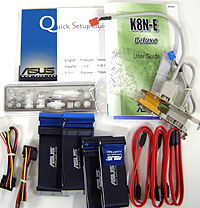Asus K8N-E Deluxe Motherboard Review
By now it should be clear that 2004 is a transition year
between old and new technologies. If you're an enthusiast it's a very exciting and expensive
time, so it's no surprise that many consumers have decided to lay low till the dust settles.
Looking back, the biggest complaint coming from geeks who bought the first Athlon64 motherboards to be released was that there was a total
lack of a functioning AGP/PCI. If you're world revolves around overclocking, this is a big
limitation. Normal computer users on the other hand couldn't care less.
In any
case, in this review PCstats will be focusing on the brand new Asus K8N-E Socket 754 motherboard. This little baby is powered by nVidia's nForce3-250Gb chipset, and comes loaded with features like an additional four port Serial ATA/RAID Silicon Image controller, Gigabit IDE RAID, 8.1 channel audio and IEEE 1394a. On the software front, the bundle lists WinDV Platinum 5, WinDVD Creator Platinum 2 and WinRip2 software among the titles.
 |
|
Asus K8N-E Deluxe Motherboard |
|
|

 |
| Includes: |
|
Users Manual, Motherboard Sticker, Quick Setup
Guide, WinDVD Software Suite, Driver CD, Two Ultra/133 IDE
Cables, One Ultra/33 IDE Cable, One Floppy Drive Cable, Four
Serial ATA Cables, Two Molex Y Serial ATA Splitter Cables,
Game Port/USB Port Bracket, IEEE 1394a Bracket, I/O
Shield |
 | | |
The Asus K8N-E Deluxe motherboard comes in the standard 'Asus brown' shade, and maintains
a pretty good component layout that won't cause too many headaches when you
go to install it. All the IEEE 1394 and Serial ATA headers are at the bottom,
and well out of the way.
The
nForce3 250GB chipset gets passed off with a dead silent, totally passive
heatsink that is kind small. When the board is overclocked, this
little BGA heatsinks gets warm, so point a fan in its direction if you
feel it is holding things back. If you're
interested in learning a bit more on nForce3-250 technology make sure you
check out our Epox 8KDA3+ review.

I've
never understood
why all nForce3-250 based motherboard have their two native Serial ATA channels positioned
right above the AGP slot. I suppose they don't really interfere with anything, but it's an odd
location to place something like that.
 As you can see from the picture on the right, Asus has implemented
a new type of videocard locking slot. It's certainly easier to use than
the older systems which required a switch, and can be accessed from both the top
and bottom. It's handy for those of us wth high end cards with memory
RAMsinks. As you can see from the picture on the right, Asus has implemented
a new type of videocard locking slot. It's certainly easier to use than
the older systems which required a switch, and can be accessed from both the top
and bottom. It's handy for those of us wth high end cards with memory
RAMsinks.
Frequent readers of PCStats
know that I have ripped a lot of older onboard audio codec's for
sapping too much CPU power and providing low quality audio. Manufacturers have
heard our complaints, yes and the quality of sound and features has certainly gone up!
Cool features like a set of SPDIF outputs (coaxial and optical) on the rear I/O
only make things sweeter!
|

